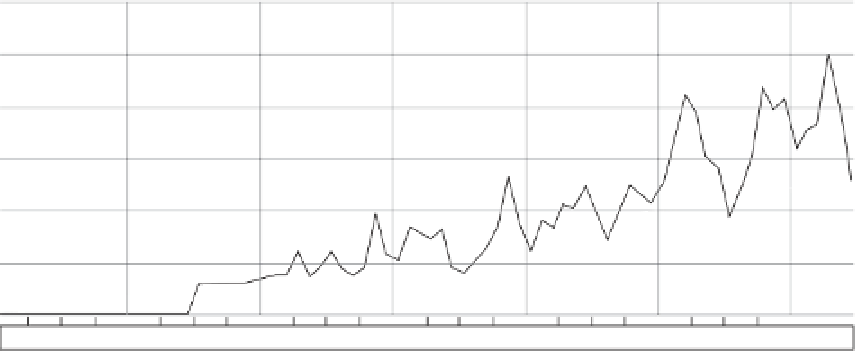Geoscience Reference
In-Depth Information
A
B
C
100
D
G
F
80
I
E
J
60
H
L
N
K
40
M
O
20
0
2004
2005
2006
2007
2008
2009
Time
Figure 13.8
Google Insights search for 'ocean acidii cation' from 2004 to mid 2010 taken in July 2010. The data are displayed on a scale of 0 to 100,
after normalization; each point on the graph has been divided by the highest point or 100. The l ags indicate specii c activities that occurred at the time:
O, the launch of the Royal Society Working Group on ocean acidii cation (published in summer, Royal Society 2005); N, is when Scientifi c American and the
New Yorker had articles on ocean acidii cation; M and L, the period of the Avoiding Dangerous Climate Change Symposium and book publication; K, the
period of the NSF, NOAA, USGS report on the impacts of ocean acidii cation on coral reefs and other marine calcii ers (Kleypas et al. 2006 ); J, publication of
the IPCC 4th Assessment Report on Climate Change (which featured ocean acidii cation for the i rst time); I, the period when key articles were published
such as on upwelling of high-CO
2
water off the west coast of North America (Feely et al. 2008) and the vulnerability of calcii ers around natural CO
2
vents
( Hall-Spencer et al. 2008); H, the Oceans in a High-CO
2
World Symposium II, Monaco; G, the Monaco declaration of concern; F, the attention received by the
CBD legal proceedings against the EPA; E, the Interacademy Statement on ocean acidii cation; D, the threat of high-CO
2
waters to Alaskan i sheries; C, the
launch of the i lm 'Acid test'; B, the speech by the UK Secretary of State for the Environment at Oceans Day and other ocean acidii cation activities during
COP15. Activity remains high post-COP15 culminating in A, the publication of a paper on the behavioural response of i sh to predators under high CO
2
( Munday et al. 2010). It should be noted that the increasing baseline interest in ocean acidii cation since 2004 is also in response to the increasing numbers
of research publications over this period stimulating increasing 'take up' by stakeholders.
public communication of ocean acidii cation, its
impacts, and potential consequences. Openness,
honesty, and clarity of message are the key ingredi-
ents for building a strong relationship with these
journalists, a relationship that must be founded on
integrity and trust. Prior to and during the COP15
negotiations, the UK press and media, at least,
became highly engaged with ocean acidii cation as
a topic of interest to their audiences. The straight-
forward nature of the science, the pioneering stage
the research has reached, and the potential impacts
contain all of the ingredients for an interesting sto-
ryline. Ocean acidii cation scientists have shown
through various publications (summarized in
Fig.1.3 in Chapter 1) their desire to ensure that clear
and accurate messages are provided to the press
and media, demonstrating a willingness to engage
with this key group of stakeholders and an under-
standing of the needs of journalists. A good exam-
ple of this is the production of responses to
frequently asked questions posed by policymakers,
the public, and climate change deniers by experts
from around the world (Kleypas
et al
. 2010 ).
Google Insights for Search Index (Fig. 13.8) on
'ocean acidii cation' is an indication of the growing
worldwide web attention that the topic has received
since the publication of the Royal Society Report in
2005 and culminating in the ocean acidii cation
activities on the lead up to, during, and after the
COP15 negotiations in Copenhagen in December
2009.
13.6.3 Communication and the next
generation
While global warming and climate change are well-
known concepts among young people, ocean acidi-
i cation is new to most of them. It is therefore
important to share knowledge about ocean acidii -
cation with schools and the younger generation. For


























